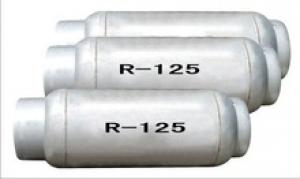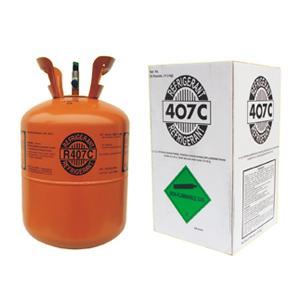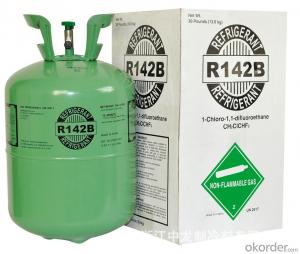Refrigerant R409a
- Loading Port:
- Shanghai
- Payment Terms:
- TT OR LC
- Min Order Qty:
- -
- Supply Capability:
- 1000MT m.t./month
OKorder Service Pledge
OKorder Financial Service
You Might Also Like
Specifications
1.Outstanding performance
2.Perfect quality and reasonable price
3.All different kinds of packages
4.Delivery fast
5.OEM
Mixed Refrigerant R409A
Property and Application
R409a by refrigerant R22,refrigerant R124 and refrigerant R142b mixed and become,at normal temperature colorless gas,in their own pressure colorless transparent liquid,is the substitute R12,mainly used in refrigeration system,the low temperature commercial refrigeration equipment.
Property of chloride
Molecular Weight | 97.4 |
B.P | -34.5°C |
The critical temperature | -°C |
Critical temperature | 106.8°C |
Critical pressure | 4.69Mpa |
Saturated liquid density(30°C) | 1.216g/cm3 |
Liquid heat(30°C) | 0.29KJ(Kg. °C) |
Constant pressure steam heat(Cp)(30°Cand101.3kpa) | 0.17 KJ(Kg. °C) |
ODP | 0.039 |
Quality Standard
Appearance | Colorless,transparent |
Odor | Slight ether |
Purity | ≥99.5% |
Water PPM | ≤10 |
Acidity PPM acuities | ≤0.1 |
Residue on evaporation | ≤0.01% |
PACKAGE
Specification | 30lb Disposable Can | 926LNon-disposablecan | ISO-TANK |
Net Weight(KG) | 13.6 | 900 | 18000 |
Size(mm) | / | / | / |
- Q: High school chemical hydrocarbons with hydrocarbon derivatives with water solubility, density for accurate and comprehensive summary, thank you. Out of college entrance examination
- Hydrocarbons, halogenated hydrocarbons, esters are difficult to dissolve in water. Hydrocarbons, esters are denser than water, and the density of halogenated hydrocarbons is generally greater than that of water. Hydrocarbon derivatives containing hydroxyl, amino or aldehyde groups such as alcohols, phenols, aldehydes, carboxylic acids, sulfonic acids and amines are soluble in water, And the shorter the solubility of the carbon chain, the greater the solubility of the carbon chain increases, until the same number of carbon atoms and similar hydrocarbons.
- Q: Identification of Derivatives of Chemical Hydrocarbons in High School
- Meaning that the halogenated hydrocarbon can be hydrolyzed and eliminated; the alcohol reacts with sodium to produce oxidation and eliminate the reaction; the phenol has acidity, can replace the reaction and color reaction; aldehyde can be added reaction and oxidation reaction. Finally remember the acid and acid, and alcohol esterification reaction.
- Q: Hydrocarbons and hydrocarbon derivatives are not all non-electrolytes
- Hydrocarbons are, derivatives are not necessarily, such as organic acids (formic acid, acetic acid, etc.)
- Q: How to do it? Solve Inorganic Chemistry
- Inorganic chemistry is one of the earliest disciplines in the development of chemical science. It undertakes a major task of studying the composition, structure, properties and reactions of all elements and elements (except hydrocarbons and derivatives). The current development of inorganic chemistry has two distinct trends, that is, in the breadth of the broadening and depth of the advance. It is the three pillars of modern civilization
- Q: Organic chemistry studies the performance of hydrocarbons and their derivatives, either right or wrong
- Correct
- Q: What cells are composed of compounds
- The organic matter that constitutes the cell generally refers to the general term for carbon-containing compounds or hydrocarbons and their derivatives. In nature, the types of organic matter are extremely numerous. Among them, organic compounds - carbohydrates, proteins and nucleic acids, which are composed of carbon, hydrogen, oxygen, nitrogen, sulfur and phosphorus, are the most important organic compounds in cells.
- Q: What is organic matter? Candle is organic?
- Organic matter refers to the addition: carbon, carbon monoxide, carbon dioxide, carbonated and carbonate carbon compounds
- Q: Organic chemistry, naming of derivatives containing oxygen (hetero) atomic bridged cyclic hydrocarbons
- A little bit of a way to draw out with chemdraw, then convert structure to name
- Q: Why artemisinin and its derivatives in the molecular structure of a peroxide chain, the chemical properties are more stable?
- Stable, then it will not be 60 degrees that is broken down, there is no need for rectal administration ... ...
- Q: Are hydrocarbons are hydrocarbons and that alcohols? Is it carbon dioxide?
- Is a hydrocarbon derivative.
Send your message to us
Refrigerant R409a
- Loading Port:
- Shanghai
- Payment Terms:
- TT OR LC
- Min Order Qty:
- -
- Supply Capability:
- 1000MT m.t./month
OKorder Service Pledge
OKorder Financial Service
Similar products
Hot products
Hot Searches























